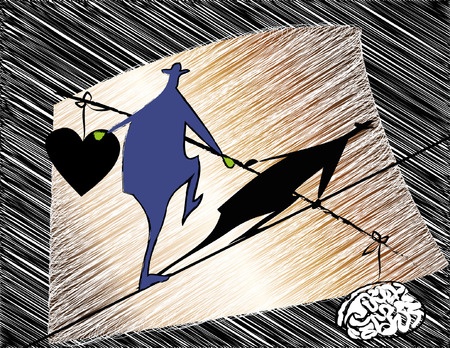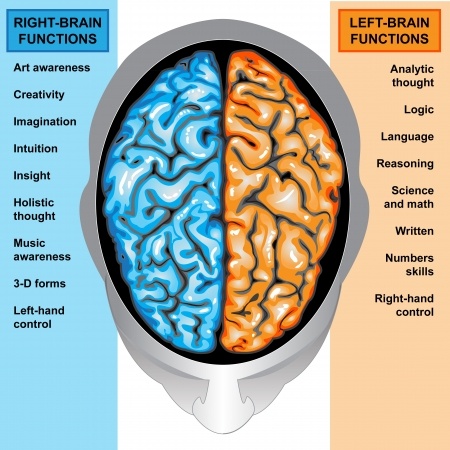
Brain lateralization refers to the functional specialization of the two cerebral hemispheres. The left hemisphere of most adults is more active than the right during language production, while the reverse pattern has been observed during tasks involving visuospatial abilities. These findings are among the most replicated in neuropsychological research studies.
Brain Lateralization
In psychology, the theory of right and left brain function is known as ‘brain lateralization.’ The concept evolved from the work of neuropsychologist Roger W. Sperry, who won the 1981 Nobel Peace Prize for research indicating that each side of the brain controls different types of thinking.
Continuing research on brainwave activity and cognition has contributed to our growing understanding of the phenomenon. Studies now suggest that language, originally thought to be a left hemisphere function, is a split brain operation; tone and voice patterns are recognized in the right brain, while word meaning and order are processed in the left brain. Infants demonstrate considerably more activity in the right hemisphere than in the left when they begin communicating orally, which is instinctively understood by parents who use melodic cues and voice inflections, or ‘baby talk,’ with their children. Research further indicates that deviance in the childhood development of this right and left brain linguistic hierarchy may relate to Autism Spectrum Disorders (see Scientific Learning article here).
Scientists have also found that the left hemisphere shows a preference for interacting more exclusively within itself, especially in the regions of the brain linked to language and fine motor control. Conversely, in the right hemisphere, brain regions linked to attention span, spatial processing, and visualization interacted in a more integrative fashion with both hemispheres (see National Academy of Sciences article here).
Suggestibility: Right & Left Brain Thinking
 In this context, the term suggestibility is associated with induction of the hypnotic state. Suggestibility is the way we learn, perceive, and assign meaning to information, and is determined by gauging whether one prefers right or left brained thinking. Dr. John Kappas, PhD, founder of the Hypnosis Motivation Institute, revolutionized hypnosis by pioneering his theory of the three types of suggestibility:
In this context, the term suggestibility is associated with induction of the hypnotic state. Suggestibility is the way we learn, perceive, and assign meaning to information, and is determined by gauging whether one prefers right or left brained thinking. Dr. John Kappas, PhD, founder of the Hypnosis Motivation Institute, revolutionized hypnosis by pioneering his theory of the three types of suggestibility:
- Physical Suggestibility: Characterized by responsiveness to literal suggestions influencing physical responses over emotions. The physical suggestible learns literally and is considered to be right brain lateralized.
- Emotional Suggestibility: Characterized by responsiveness to inferred suggestions that influence emotions over physical responses. The emotional suggestible learns by inference and is considered to be left brain lateralized.
- Intellectual Suggestibility: A sub-category of emotional suggestibility characterized by fear of being controlled by the hypnotist, as well as by analysis, rejection, and rationalization of suggestions. Intellectual suggestible subjects are considered to be severely left brain lateralized (80% or higher) and must be maneuvered into hypnotizing themselves.
According to this theory, predisposition to right or left brain thinking occurs in the formative years of upbringing in response to fulfillment of fundamental needs, and is influenced by an individual’s relationship with their primary caregiver. Dr. Kappas developed a comprehensive system of questions, instructions, and observations for equivocating the approximate degree of physical or emotional suggestibility in subjects as part of the hypnotic induction process. When used properly, this approach induces hypnosis in virtually anyone.
Synchronization Of Hemispheres
The physiology of brain lateralization occurs through an intricate network of nerve fibers called the corpus callosum, which connects the brain cells in the right and left hemispheres and acts as a bridge of communication. A unique characteristic of this ‘neurological crossover’ is that the left hemisphere controls the right side of the body, and the right hemisphere controls the left side of the body. This also means that left body sensory data is processed in the right brain, and right body sensory data is processed in the left brain.
 Accordingly, during hypnosis a person’s suggestibility can be altered by use of right or left body ideomotor responses; common examples are fingers, hands, or arms raised in response to suggestive questions. The brain hemispheres are thus stimulated to share perception of a problem in a more balanced way, changing the mental processes and emotional reactions. For instance, a physical suggestible who is having difficulty getting over the passing of a loved one encounters the challenge from a right brained, emotive viewpoint. Ideomotor responses focused on the right side of the body lateralize their thinking process to the logical and analytical left brain. This hypnotic technique shifts the individual’s perspective from the literal pain of grieving to the inference of accepting the loss.
Accordingly, during hypnosis a person’s suggestibility can be altered by use of right or left body ideomotor responses; common examples are fingers, hands, or arms raised in response to suggestive questions. The brain hemispheres are thus stimulated to share perception of a problem in a more balanced way, changing the mental processes and emotional reactions. For instance, a physical suggestible who is having difficulty getting over the passing of a loved one encounters the challenge from a right brained, emotive viewpoint. Ideomotor responses focused on the right side of the body lateralize their thinking process to the logical and analytical left brain. This hypnotic technique shifts the individual’s perspective from the literal pain of grieving to the inference of accepting the loss.
While ideomotor desensitization in hypnotherapy can alter suggestibility to particular problems, we revert to our familiar literal or inferred thinking in everyday life. On a long term basis, daily meditation and self-hypnosis, which engage integrative right hemisphere brainwave activity, have proven highly effective in achieving hemispheric synchronicity, particularly for individuals prone to left brain thinking and for right brain thinkers whose daily lives demand a left brained presence.
©2013 Shawn Quinlivan, C.Ht. & Cathexis Therapeutic Imagery
